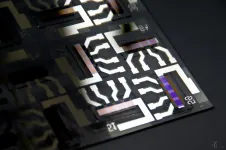(Press-News.org) GREEN TRANSITION Researchers at the University of Copenhagen have demonstrated that unique fungi strengthen the "immune systems" of wheat and bean plants against aphids. Fungi enter and influence the amount of a plant's own defences, resulting in fewer aphids. The results could serve to reduce agricultural insecticide use and bring Denmark a step further along the path towards its green transition.
Wheat field
Certain fungi are able to establish a close rapport with plants that results in fewer insect infestations and thereby less damage to crops. Until now, it was unclear how these fungi could be used to reduce insect infestations.
"In order for us to really use fungi to control agricultural pests in the future, we need to understand the mechanisms and processes behind their activity. So, it's very exciting that we have managed to advance a step closer", says Associate Professor Nicolai Vitt Meyling of UCPH's Department of Plant and Environmental Sciences.
Fungi strengthen the "immune systems" of crops
The researchers studied three types of fungi to compare their effects against aphid infestations on wheat and bean plants:
"It turned out that two of these fungi were able to effectively reduce aphid infestations by establishing themselves in plant roots and tissues. By combining greenhouse-based experiments with advanced chemical analyses, we can see that the fungi cause plants to increase production of their own natural defences, thus strengthening plant "immune systems". This translates into fewer aphids, which would otherwise weaken a plant", says Nicolai Vitt Meyling, who explains:
"When aphids suck up plant sap, plants lose energy, to the detriment of their root networks and overall growth. However, when fungi-treated plants were attacked by aphids, they were able to compensate by increasing root growth, so that they didn't lose growth potential. Plants left untreated with the fungi couldn't compensate for the attack," says Nicolai Vitt Meyling.
The researchers "treated" wheat and bean plants by applying fungal spores to seed, from which the plants were then germinated and cultivated. They then added a few aphids and observed how many more aphids developed over two weeks in the greenhouse. Thereafter, plant leaves underwent chemical analysis in collaboration with researchers from Aarhus University's Department of Agroecology.
"We see a clear correlation between an increased amount of defence substances in and fewer aphids on the plants treated with two of the fungi. Those plants left untreated with the fungi had lesser amounts of defence substances and more aphids. There is simply a marked upregulation of defence substances in a plant under aphid attack when these specific fungi are present. And, the same treatment produces the same result in both wheat and bean plants," says Nicolai Vitt Meyling.
Thus, the researchers could see that the effect is related to the fungi and not the plant species. The same fungi had the same effect in both the wheat and bean plants, despite the two types of plants not being related and expressing different kinds of defence substances.
Swapping out insecticide for fungi coated seed
The fungi also have an effect on insects that attack the root systems of plants. And, in combination with other environmentally-friendly cultivation methods, could help to reduce insecticide use in agriculture.
"The fungi has the potential to reduce the need for insecticides because treated seeds result in fewer aphids in the field. If we can develop a large-scale method of pre-treating seed with Danish seed producers, to coat plant seeds with these fungi before planting, we may hardly need to spray with insecticides," says Nicolai Vitt Meyling, who concludes:
"Limiting pesticide use is an important aspect of the green transition. This can be an effective and sustainable contribution towards such a reduction."
The next step is to engage in longer term field trials of treated plants. This will allow researchers to gauge the longevity of effects under realistic growing conditions.
The research results have been published in the renowned scientific journal New Phytologist.
INFORMATION:
PHILADELPHIA, PA (January 22, 2021) - Advancements in diabetes technology have improved quality of life and glycemic control in children with type 1 diabetes. However, data show that a subset of children is being left behind. Those from low-income families and non-Hispanic Black (NHB) children are not experiencing benefits associated with technological advances, and are at higher risk for diabetes complications and adverse outcomes through ongoing poor glycemic control.
In an invited commentary to be published in the journal Diabetes Care, researchers describe how socioeconomic disparities ...
Researchers from Queen Mary University of London, have identified a protein that may represent a novel therapeutic target for the treatment of pancreatic cancer. Using this protein as a target, the team successfully created a CAR T cell therapy - a type of immunotherapy - that killed pancreatic cancer cells in a pre-clinical model.
CAR T cell therapy is an immunotherapy that has shown great promise for the treatment of some blood cancers; however, the treatment of solid tumours using this therapy has proved very difficult. One barrier to success is toxicity in tissues other than the cancer because most of the proteins currently used to target CAR T cells to pancreatic cancer cells and other solid tumours are present in low levels on other normal tissues, ...
Organic photodetectors (OPDs) have a huge potential for applications in low-cost imaging, health monitoring and near infrared sensing. Yet, before industrially realizing these applications, the performance of these devices still needs to be improved.
Recent research on organic photodetectors based on donor-acceptor systems has resulted in narrow-band, flexible and biocompatible devices, of which the best reach external photovoltaic quantum efficiencies of close to 100%. However, the high noise in the off state produced by these devices limits their specific detectivity, severely reducing the performance, for example ...
Popular in aquariums all over the world, the zebrafish is native to South Asia. But here in a Cincinnati Children's laboratory, the freshwater variant plays a vital role in scientific discovery.
The iconic stripes are eye-catching but it's the transparency of zebrafish embryonic tissue which are most prized by researchers like Oriana Zinani, a fifth-year doctoral student in molecular developmental biology in the University of Cincinnati College of Medicine. The patterning of the zebrafish's spine gives the appearance of stripes; it is controlled by ...
In science, sometimes a new perspective can turn our interpretation of the data upside-down, and necessitate a paradigm shift.
There has been, and continues to be, fierce disagreements in nutrition science as to what constitutes a healthy diet. A key controversy is the role of saturated fats in health and disease. Saturated fats are known to increase blood cholesterol levels, and increased blood cholesterol is often observed in people who develop cardiovascular disease.
It has been thought for more than half a century that saturated fats in the diet promote heart disease by increasing blood cholesterol. However, a new model explains why this so-called "diet-heart hypothesis", which ...
Professor MATSUYAMA Hideto's research group at Kobe University's Research Center for Membrane and Film Technology has successfully developed a new desalination membrane. They achieved this by laminating a two-dimensional carbon material (*1) on to the surface of a porous polymer membrane (*2).
Desalination (*3) membranes are used to produce freshwater from seawater. In order to solve the worldwide issue of insufficient freshwater resources, researchers are striving to develop desalination membranes that are not only permeated by water faster than those currently in use but also remove salt efficiently, so that more effective, low-energy desalination systems can be implemented.
In this research study, graphene oxide (*4) nanosheets, which ...
Real-world materials are usually messier than the idealized scenarios found in textbooks. Imperfections can add complications and even limit a material's usefulness. To get around this, scientists routinely strive to remove defects and dirt entirely, pushing materials closer to perfection. Now, researchers at the University of Illinois at Urbana-Champaign have turned this problem around and shown that for some materials defects could act as a probe for interesting physics, rather than a nuisance.
The team, led by professors Gaurav Bahl and Taylor Hughes, studied artificial materials, or metamaterials, which they engineered to include defects. The team used these customizable circuits as a proxy for studying exotic topological crystals, which are often ...
Marine microalgae-based cellular agriculture is a promising new way to sustainably produce plant-based 'meat' and healthy 'superfoods' for the future.
Researchers at Flinders University's Centre for Marine Bioproducts Development (CMBD) in Australia are responding to growing interest from consumers looking for healthier, more environmentally friendly, sustainable and ethical alternatives to animal proteins.
Marine microalgae, single-cell photosynthetic organisms from the ocean could be the solution to the world's meat protein shortage, says CMBD director Flinders University Professor Wei Zhang, who is also co-leading a bid to establish a national Marine Bioproducts Cooperative Research Centre ...
Young rugby league players could benefit from individualised nutrition plans to maximise performance and optimise recovery throughout their careers, according to QUT researchers.
The new study, published in the International Journal of Sport Nutrition and Exercise Metabolism, provides nutritional recommendations and considers potential supplements to improve players' physical capacity, health and recovery during the preparatory and competition phases of a season.
Lead researcher, Associate Professor Vince Kelly from QUT's Faculty of Health's Exercise and Nutrition Sciences, is a committee member of the National Rugby League Research Committee and has more than 20 years' experience in elite sport.
"Young players don't have the same access to dietary support as professional ...
Nanofiltration (NF) is an advanced technology for treating wastewater containing organic micropollutants (OMPs).
Recently, a research group led by Prof. WAN Yinhua from the Institute of Process Engineering (IPE) of the Chinese Academy of Sciences developed a stable graphene oxide nanofiltration membrane with uniform pore size to remove OMPs.
The study was published in Chemical Engineering Journal on Jan. 20.
It proposes combining signal amplification strategy and defect chemistry to reduce membrane pore size distribution, thus offering a promising method for preparing highly ...






